Abstract
We present new algorithms for computing theH ∞ optimal performance for a class of single-input/single-output (SISO) infinite-dimensional systems. The algorithms here only require use of one or two fast Fourier transforms (FFT) and Cholesky decompositions; hence the algorithms are particularly simple and easy to implement. Numerical examples show that the algorithms are stable and efficient and converge rapidly. The method has wide applications including to theH ∞ optimal control of distributed parameter systems. We illustrate the technique with applications to some delay problems and a partial differential equation (PDE) model. The algorithms we present are also an attractive approach to the solution of high-order finite-dimensional models for which use of state space methods would present computational difficulties.
Similar content being viewed by others
References
Ball, J. A., Helton, J. W.(1983). A Beurling-Lax theorem for the Lie groupu(m,n) which contains most classical interpolation theory,J. Operator Theory 9(1), 107–142.
Clough, R. W., and Penzien, J. (1975).Dynamics of Structures, McGraw-Hill, New York.
Doyle, J. C., and Stein, G. (1980). Multivariable feedback design: Concepts for a classical/ modern synthesis,IEEE Trans. Automatic Control AC-26(1), 4–16.
Fagnani, F. (1991). An operator-theoretic approach to the mixed-sensitivity minimization problem,Syst. Control Lett. 17, 227–235.
Flamm, D. S. (1986). Control of Delay Systems for Minimax Sensitivity, Technical Report No. LIDS-TH-1560, Massachusetts Institute of Technology Laboratory for Information and Decision Systems.
Flamm, D. S. (1990). A Model of a Damped Flexible Beam, ISS Report No. 54, Department of Electrical Engineering, Princeton University.
Flamm, D. S. and Yang, H. (1990). Optimal mixed sensitivity for general distributed plants, to appear inIEEE Trans. Automatic Control.
Foias, C., Tannenbaum, A., and Zames, G. (1986). Weighted sensitivity minimization for delay systems,IEEE Trans. Automatic Control AC-31(8), 763–766.
Francis, B., Helton, J. W., and Zames, G. (1984).H ∞-optimal feedback controllers for linear multivariable systems,IEEE Trans. Automatic Control AC-29(10), 888–900.
Francis, B. A. (1987). A Course inH ∞ Control Theory, Springer-Verlag, New York.
Hoffman, K. (1962).Banach Spaces of Analytic Functions, Prentice-Hall, Englewood Cliffs, New Jersey.
Orszag, J. M., and Yang, H. (1992). Portfolio Choice with Knightian Uncertainty, Department of Economics, University of Michigan.
Rosenblum, M., and Rovnyak, J. (1985).Hardy Classes and Operator Theory, Oxford University Press, Oxford.
Safonov, M. G., Laub, A. J., and Hartmann, G. (1980). Feedback properties of multivariable systems: The role and use of the return difference matrix,IEEEE Trans. Automatic Control AC-26(1), 47–65.
Sarason, D. (1985). Operator-theoretic aspects of the Nevanlinna-Pick interpolation problem, inOperator and Function Theory, pages 279–314, 1985.
Yang, H. (1993). 311–03 optimal compensators for a class of infinite dimensional systems, submitted toAmerican Control Conference 1993.
Yang, H. (1992). Frequency domain method forH ∞ optimal mixed sensitivity design, manuscript.
Yang, H., and Flamm, D. S. (1990). Mixed sensitivity design for a class of multivariable infinite dimensional systems. Submitted toIEEE Transactions on Automatic Control.
Yang, H., and Orszag, J. M. (1992). Spectral and nonparametric optimization methods for portfolio choice. Princeton University Program in Applied and Computational Mathematics, October 1992.
Author information
Authors and Affiliations
Rights and permissions
About this article
Cite this article
Yang, H., Orszag, J.M. Numerical computation of H∞ optimal performance. J Sci Comput 7, 289–311 (1992). https://doi.org/10.1007/BF01108034
Received:
Issue Date:
DOI: https://doi.org/10.1007/BF01108034




